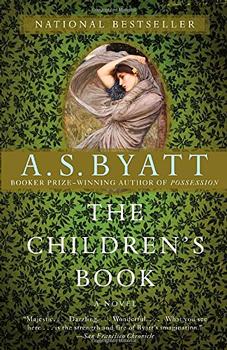Summary | Excerpt | Reading Guide | Reviews | Beyond the Book | Readalikes | Genres & Themes | Author Bio

A Novel
by A.S. ByattExcerpt
The Children's Book
Two boys stood in the Prince Consort Gallery, and looked down on a third. It was June 19th, 1895. The Prince had died in 1861, and had seen only the beginnings of his ambitious project for a gathering of museums in which the British craftsmen could study the best examples of design. His portrait, modest and medalled, was done in mosaic in the tympanum of a decorative arch at one end of the narrow gallery which ran above the space of the South Court. The South Court was decorated with further mosaics, portraits of painters, sculptors, potters, the "Kensington Valhalla." The third boy was squatting beside one of a series of imposing glass cases displaying gold and silver treasures. Tom, the younger of the two looking down, thought of Snow White in her glass coffin. He thought also, looking up at Albert, that the vessels and spoons and caskets, gleaming in the liquid light under the glass, were like a resurrected kingly burial hoard. (Which, indeed, some of them were.) They could not see the other boy clearly, because he was on the far side of a case. He appeared to be sketching its contents.
Julian Cain was at home in the South Kensington Museum. His father, Major Prosper Cain, was Special Keeper of Precious Metals.
Julian was just fifteen, and a boarder at Marlowe School, but was home recovering from a nasty bout of jaundice. He was neither tall nor short, slightly built, with a sharp face and a sallow complexion, even without the jaundice. He wore his straight black hair parted in the centre, and was dressed in a school suit. Tom Wellwood, boyish in Norfolk jacket and breeches, was about two years younger, and looked younger than he was, with large dark eyes, a soft mouth and a smooth head of dark gold hair. The two had not met before. Tom's mother was visiting Julian's father, to ask for help with her research. She was a successful authoress of magical tales. Julian had been deputed to show Tom the treasures. He appeared to be more interested in showing him the squatting boy.
"I said I'd show you a mystery."
"I thought you meant one of the treasures."
"No, I meant him. There's something shifty about him. I've been keeping an eye on him. He's up to something."
Tom was not sure whether this was the sort of make-believe his own family practised, tracking complete strangers and inventing stories about them. He wasn't sure if Julian was, so to speak, playing at being responsible.
"What does he do?"
"He does the Indian rope trick. He disappears. Now you see him, now you don't. He's here every day. All by himself. But you can't see where or when he goes."
They sidled along the wrought-iron gallery, which was hung with thick red velvet curtains. The third boy stayed where he was, drawing intently. Then he moved his position, to see from another angle. He was hay-haired, shaggy and filthy. He had cut-down workmen's trousers, with braces, over a flannel shirt the colour of smoke, stained with soot. Julian said "We could go down and stalk him. There are all sorts of odd things about him. He looks very rough. He never seems to go anywhere but here. I've waited at the exit to see him leave, and follow him, and he doesn't seem to leave. He seems to be a permanent fixture."
The boy looked up, briefly, his grimy face creased in a frown. Tom said "He concentrates."
"He never talks to anyone that I can see. Now and then the art students look at his drawings. But he doesn't chat to them. He just creeps about the place. It's sinister."
"Do you get many robberies?"
"My father always says the keepers are criminally casual with the keys to the cases. And there are heaps and heaps of stuff lying around waiting to be catalogued, or sent to Bethnal Green. It would be terribly easy to sneak off with things. I don't even know if anyone would notice if you did, not with some of the things, though they'd notice quickly enough if anyone made an attempt on the Candlestick."
Excerpted from The Children's Book by A.S. Byatt Copyright © 2009 by A.S. Byatt. Excerpted by permission of Knopf, a division of Random House, Inc. All rights reserved. No part of this excerpt may be reproduced or reprinted without permission in writing from the publisher.
To be ignorant of what occurred before you were born is to remain always a child
Click Here to find out who said this, as well as discovering other famous literary quotes!
Your guide toexceptional books
BookBrowse seeks out and recommends the best in contemporary fiction and nonfiction—books that not only engage and entertain but also deepen our understanding of ourselves and the world around us.